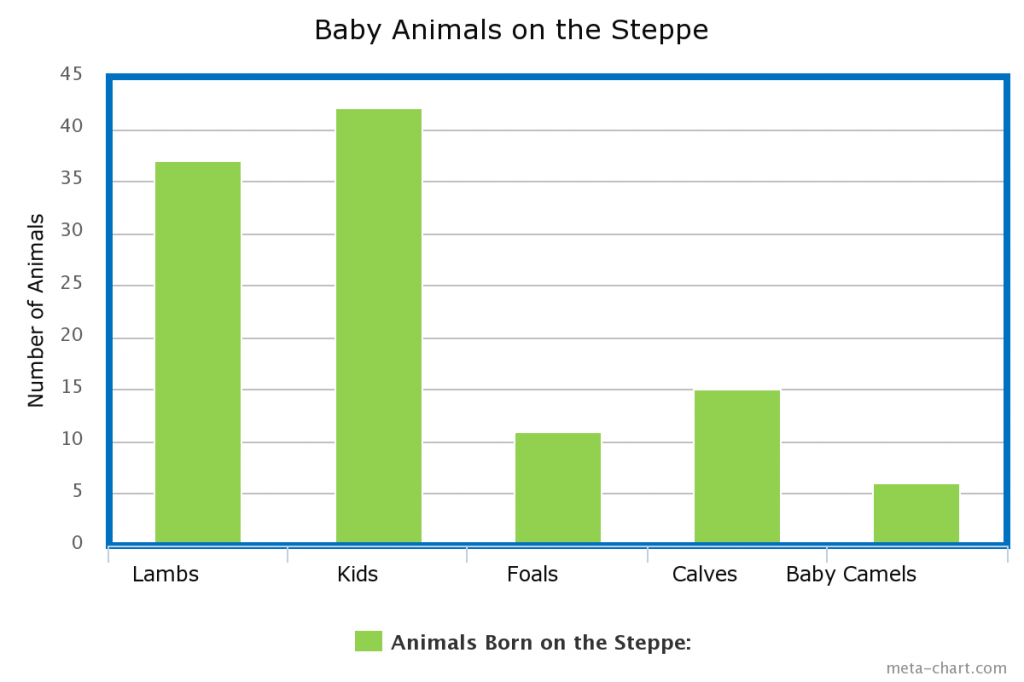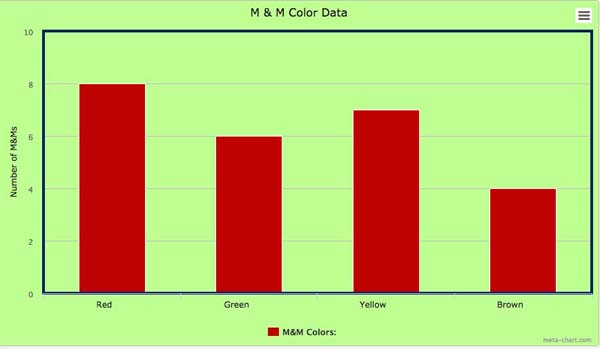Discussion/Introduction
In third grade we get to liven up our bar chart lessons by taking advantage of our students’ new familiarity with multiplication and division. By the end of third grade, the Common Core recommends that students know from memory all products of two one digit numbers. By the time you schedule your bar chart lesson, your students should be comfortable doing skip counting by twos, threes, fives or tens; and that means they shouldn’t have any difficulty interpreting a scaled bar chart.
.
Calves, Baby Camels and a Scaled Bar Chart Lesson
Objective
In this 3rd grade bar chart lesson, students will learn to analyze and understand data presented on a scaled bar chart. They will learn how to do both simple and multi-step comparing problems using the bar chart.
Supplies
• Graph printout from www.meta-chart.com/bar/ , or, if your classroom has projector capabilities, a graph prepared and saved on your laptop.
• One sheet of graphing paper for display, with large squares and a height of about ten squares
• Graphing paper and markers for each student
Methodology/Procedure
Start this lesson with a bit of storytelling. Math and imaginative thinking go well together, and starting a new math topic with an imaginative exercise means you’ll have the attention not only of your technically minded, mathy children but also of those who love their English but usually ‘turn off’ when they come into your classroom.
Once upon a time, far away, in the wild open steppe land of Mongolia, two children lived with their old grandfather and grandmother in a little round tent made of felt. Their little tent was alone on the steppeland; for as far as they could see to the east, west, north and south there was nothing but waving grasses and wooded hills. That, and the camels, yaks, sheep and horses which made up the family wealth.
It was Temuujin’s job to take the horses and yaks to pasture every morning, and Zolzaya, his little sister, took the sheep and goats to the green grass on the other side of the hill. Grandma and Grandpa were getting old, and though they still hobbled around, checked everything, and told the two children what to do, they were past the age for active work.
Then came the spring when Grandpa’s legs were so bad he could not make his rounds of the herds as he had used to. He had to stay in his bed by the fire, and the furthest he could move was to his seat by the fire. He worried about his herds, and though Temuujin and Zolzaya knew everything was going well, he wouldn’t believe them when they told him that. He would ask questions about numbers—how many more kids are there than lambs?—and numbers were not Temuujin’s strong point. When Temuujin was uncertain in answering, he would get angry and say that the boy knew nothing about taking care of animals.
One day Temuujin and Zolzaya decided to do something special to give their grandfather all the information he wanted about the animals. They would count all the lambs, kids, foals, calves and baby camels, and mark down the numbers in a tally chart. Then they would make a bar graph for their grandfather, so he could see exactly how many animals he had without having to go outdoors. They knew that with a bar graph they could solve any comparing problems he asked them just with one glance at the paper.
They were quite sure that this would make their grandfather very, very, happy, and they had exactly one sheet of graph paper to draw their bar graph on.
But when they came in from counting, both Temuujin and Zolzaya had very somber faces. This is what their numbers looked like.
• Lambs: 37
• Kids: 42
• Foals: 11
• Calves: 15
• Baby Camels: 6
And this is what their graph paper looked like:
Display a simple sheet of large-squared graph paper , with ten squares each way.
How could they put their data on this little sheet? The numbers were too big.
Stop here, and give your students a chance to discuss the problem. After a discussion break, ask for possible solutions.
Temuujin and Zolzaya realized there was only one thing to do: they could scale their bar graph so that each block on the graph paper, instead of meaning 1 animal, meant five. This made some of their numbers very easy to work with. The calves, for instance, being exactly fifteen, would be represented by a bar exactly three squares tall on the bar graph.
What about the baby camels? How could they make a bar that meant ‘six’, if each square stood for five?
Stop again for discussion. Ask any students who have solutions to share them with the class.
Temuujin realized that he would have to divide the square up, in his mind, into five equal slices, and let the camel bar go exactly one \( frac{1}{5} \) slice over into a second square.
So this is what Temuujin and Zolzaya’s graph looked like.
Display your printout of http://www.meta-chart.com/share/baby-animals-on-the-steppe, or put it on the projector.
They were very pleased when it was done, and carried it proudly in to their grandfather. And after that, they could answer all his questions with just a moment’s hesitation, whenever he asked them about the numbers of animals.
Before you go into these questions, the initial data you put on the blackboard should be erased, so that students are encouraged to base their arithmetic on the graph rather than on the raw numbers.
The first question he asked was, how many more kids are there than lambs?
Let your students decide how to solve this and the following problems, and come in with your ideas only after they have it worked out. If they get stuck, they should be encouraged to see that there is a difference between lambs and kids of just one square, so five animals.
The second question was—how many foals and baby camels are there, altogether?
If your students decide to do this problem as \( 5 cdot 2 + 5cdot frac{1}{5} + 5cdot 1 +5 cdot frac{1}{5} \) , tell them they are right—and then point out that they can also do it as \( (2 frac{1}{5}+1 frac{1}{5})5\); or, if they prefer dealing with whole numbers and fractions separately, \( 5(2+1) + frac{(1+1)}{5} cdot 5. \)
The third question was—how many baby animals are there altogether?
After your students have worked on this problem, show them that one easy way would be to add the whole numbers—7+8+2+3+1=21, add that to the sum of the fractions \((frac{2}{5}+frac{2}{5}+frac{1}{5} +frac{1}{5}) = frac{6}{5} =1 frac{1}{5}\), and multiply both by five: \( 21 cdot 5 + frac{6}{5}) cdot 5= 105+6=111\).
Grandpa’s last question—how many fewer foals are there than kids?
This can be done as \( (8-2) cdot 5; + (frac{2}{5}-frac{1}{5}) cdot 5.\)
Extension Exercise
If there is still time before the end of the lesson, ask the students if they can make a scaled bar graph to let Grandpa know how many horses, cows, and camels there are:
Horses-20
Camels -11
Cows – 18
I’ve found that students respond wonderfully to the use of stories in the math classroom, and sometimes a touch of faraway places and novel situations can make an otherwise ‘booooriing!’ math exercise almost magically fun.
 Download This lesson as a pdf
Download This lesson as a pdf
Common Core Standards
The specific section on bar charts in the 3rd grade Common Core Standards for Mathematics reads: “Draw a scaled picture graph and a scaled bar graph to represent a data set with several categories. Solve one- and two-step ‘how many more’ and ‘how many less’ problems using information presented in scaled bar graphs” [3.MD.2]. Since our students need to be familiar with reading and interpreting scaled bar charts before they can draw them independently, my scaled bar chart lesson plan, given above, focuses primarily on interpretation and problem solving. Students will also be involved in thinking through the creation of a scaled bar chart and can go on to draw their own charts in an extension exercise if time permits.



 Download this lesson
Download this lesson